Introduction
Morpho peleides Kollar, the blue morpho butterfly, also known as the peleides blue morpho or common blue morpho, is a brightly colored butterfly abundant in tropical environments in Central and South America (Figure 1). It can be seen flying in open areas such as paths, trails, forest edges, and rivers, and avoiding dense forest (Young 1973).
This butterfly is often featured in museums and zoos having butterfly houses or butterfly rainforests in the United States.
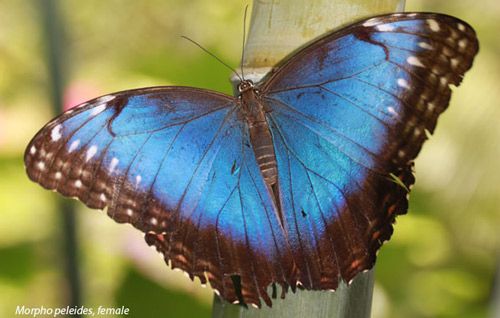
Credit: Andrei Sourakov, McGuire Center for Lepidoptera and Biodiversity, Florida Museum of Natural History, University of Florida
Synonymy
Morpho peleides Kollar (1850) is sometimes referred to as Morpho helenor peleides in the literature, as some consider it a subspecies of Morpho helenor (Butterflies of America 2015). Morpho peleides has undergone extensive diversification in Central and South America, and numerous subspecies have been described (Young and Muyshondt 1972). The following subspecies have been identified (Young 1975, Encyclopedia of Life 2015):
Morpho peleides chocoanus Kruger
Morpho peleides cortone Fruhstorfer, 1913
Morpho peleides crispitaenia Fruhstorfer, 1907
Morpho peleides faustina Rousseau-Decelle, 1935
Morpho peleides insularis Fruhstorfer, 1912, 1913
Morpho peleides joannisi Le Cerf, 1925
Morpho peleides limpida Butler, 1872
Morpho peleides luminosa Le Cerf, 1925
Morpho peleides maculata Röber, 1903
Morpho peleides narcissus Staudinger
Morpho peleides tucupita Le Moult, 1925
Morpho peleides zela Fruhstorfer, 1912
Morpho peleides zonaras Fruhstorfer, 1912
Distribution
Morpho peleides is one of the most widespread and abundant Morpho species, occurring from Mexico through Central America, and in South America down to Paraguay. It occurs in large populations in montane and lowland forests, typically in areas of secondary plant growth (Young 1973, Young 1975, Urich and Emmel 1991).
Description
Morpho peleides is recognized by the iridescent blue coloration on the dorsal (top) side of the wings (Figure 1). Conversely, the undersides of the wings are brown and have a cryptic coloration and pattern (Figure 2). Large eyespots are present on the ventral (bottom) side of the forewings and hindwings. The number of forewing eyespots on each individual may vary (Young 1982). This coloration serves as protection from predators by making the butterfly somewhat camouflaged in the forest, and the eyespots can startle or intimidate potential predators. They are large butterflies, with adult wingspan measuring 5-8 inches (127-203 mm) (Rainforest Alliance 2015).

Credit: Andrei Sourakov, McGuire Center for Lepidoptera and Biodiversity, Florida Museum of Natural History, University of Florida
Adult Morpho peleides butterflies are frugivores, or fruit feeders, and often feed on decaying fruits. Unlike most butterflies, they do not visit flowers for nectar (Knopp and Krenn 2002). They have been observed feeding on tree sap from Samanea trees (Fabaceae) (Young 1975). The adults typically feed on tree sap when decaying fruit is unavailable. Many adults can be present at the same feeding site without any aggressive interactions between them, even though they can become quite crowded (Figure 3) (Young 1975). Mating typically occurs at feeding sites or other areas where adults aggregate. Males and females are sexually dimorphic, meaning that they are able to be distinguished visually. Differences in wing appearances between the males and females help individuals locate and recognize the opposite sex (Young 1973). They can also recognize each other from different species by their flight patterns. During courtship, the male will chase the female, typically flying in a circular pattern, around a small area. Copulation can last from 8 hours to 3 days, in which the adults often rest on vegetation in tandem and rarely fly (Figure 4) (Young 1973).
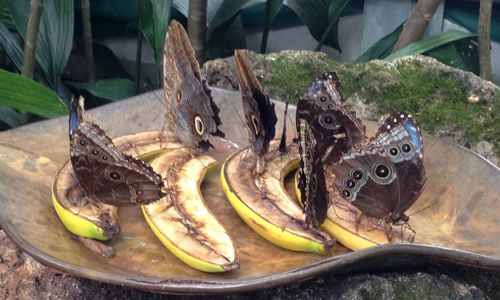
Credit: Haleigh A. Ray, University of Florida
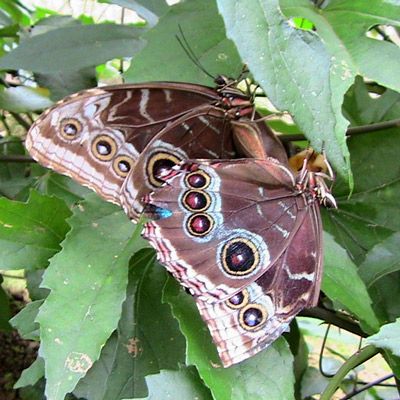
Credit: Andrei Sourakov, McGuire Center for Lepidoptera and Biodiversity, Florida Museum of Natural History, University of Florida
Life Cycle
Eggs: The eggs of Morpho peleides are small (approximately 1-2 mm in diameter), smooth, hemispherical, and laid on the upper surface of leaves (Urich and Emmel 1991, Constantino and Corredor 2004) (Figure 5). They are light green in color and have a circular band of small brown spots near the top (Figure 6). The egg stage has been recorded to last anywhere from 7 to 16 days, depending on the subspecies (Young 1982, Urich and Emmel 1991, Constantino and Corredor 2004).
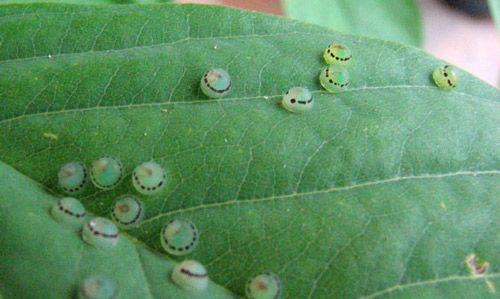
Credit: Andrei Sourakov, McGuire Center for Lepidoptera and Biodiversity, Florida Museum of Natural History, University of Florida
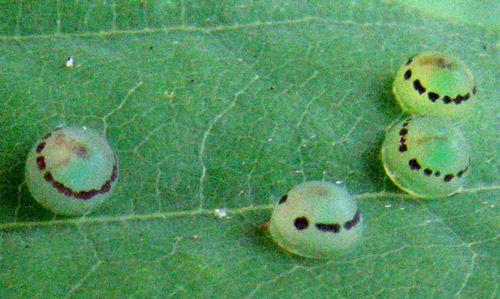
Credit: Andrei Sourakov, McGuire Center for Lepidoptera and Biodiversity, Florida Museum of Natural History, University of Florida
Larvae: The larval stage of Morpho peleides has five instars or molts. All stages of larvae are known to feed at dawn and dusk (Young and Muyshondt 1972a). When they are not feeding, the larvae remain motionless (Young 1972). A study by Urich and Emmel (1991) found that the larvae grow from 5.25 mm in length after hatching up to 93 mm in length at the fifth instar, and another study by Constantino and Corredor (2004) described the larvae as reaching 74.1 mm at the fifth instar. The growth rate and maximum size may vary by the subspecies and geographic location. Head width exceeds body width in the first three instars, and the head capsule is maroon in color and covered with hairs. In the early instars, the body is bright green-yellow with maroon patches, and pairs of red and white hair tufts (Figure 7) (Urich and Emmel 1991, Constantino and Corredor 2004). There are also white tufts of hair that extend from the sides of the body down toward the leaf surface, which may help to camouflage the caterpillar by breaking up its outline (Figure 8). By the fifth instar, the body is the same width as the head, and the head and body both change to a brownish color (Figure 9) (Urich and Emmel 1991, Constantino and Corredor 2004). Immediately before pupation the caterpillar enters a prepupal stage and the entire body color changes to light green, with only the tufts of hair on the dorsal side of the larvae remaining white and maroon (Figure 10) (Constantino and Corredor 2004). The first, second, third, fourth, and fifth instars last approximately 7, 7-8, 7-9, 8-12, and 11-14 days, respectively, with the prepupal stage lasting approximately three days (Urich and Emmel 1991, Constantino and Corredor 2004).
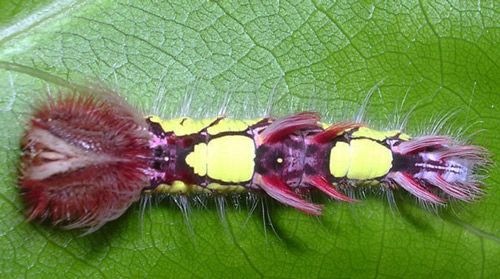
Credit: Andrei Sourakov, McGuire Center for Lepidoptera and Biodiversity, Florida Museum of Natural History, University of Florida

Credit: Andrei Sourakov, McGuire Center for Lepidoptera and Biodiversity, Florida Museum of Natural History, University of Florida

Credit: Andrei Sourakov, McGuire Center for Lepidoptera and Biodiversity, Florida Museum of Natural History, University of Florida
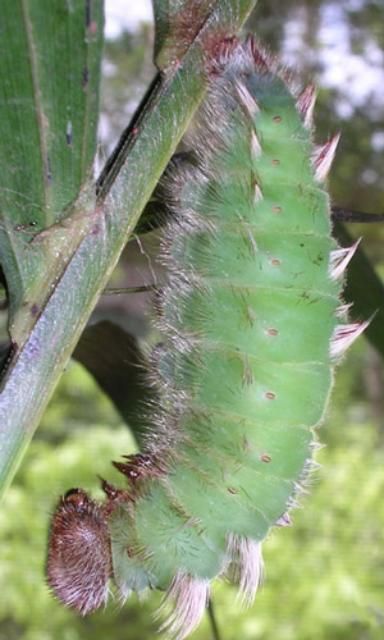
Credit: Andrei Sourakov, McGuire Center for Lepidoptera and Biodiversity, Florida Museum of Natural History, University of Florida
Pupa: The pupal stage of Morpho peleides (Figure 11) lasts approximately 14 days. During this time, the pupae are a pale green color and oval in shape. Just before the emergence of the adult butterfly, the pupal skin becomes transparent and the adult is visible.
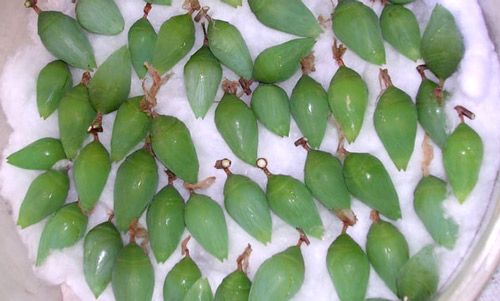
Credit: Andrei Sourakov, McGuire Center for Lepidoptera and Biodiversity, Florida Museum of Natural History, University of Florida
Adult: The adult Morpho peleides butterflies have black bodies and bright, iridescent blue wings, with the underside of the wings being cryptic brown. The margins of the wings have a black border, which is larger in females than in males. This black border has five or six white spots in the center, beginning at the apex of the forewing and extending downward (Urich and Emmel 1991). The average wingspan of an adult male Morpho peleides is 8.5±1.4 cm (Young and Muyshondt 1972).
Host Plants
Several host plants of Morpho peleides larvae have been identified, and the species is thought to have a very broad host range. According to Urich and Emmel (1991), the primary wild host plant in Trinidad is Paragonia pyramidata (Bignoniaceae), and females were observed laying eggs on Erythrina glauca and Erythrina micropteryx (both Fabaceae). Machaerium salvadorensis (Fabaceae) is the major host plant of some Morpho peleides in El Salvador, and several legumes (Fabaceae) have been reported as hosts for Morpho peleides in Costa Rica. These include Dalbergia, Lonchocarpus, Macharium, Mucuna, Platymiscium, Pterocarpus and Swartzia species (Young and Muyshondt 1972, Urich and Emmel 1991).
Selected References
Morpho helenor peleides Kollar, 1850 (common morpho). Butterflies of America. 2015. (8 June 2015).
Constantino LM, Corredor G. 2004. The biology and morphology of the early stages of Morpho macrophthalmus and Morpho peleides telamon (Nymphalidae: Morphinae) from western Colombia. Boletín Científico del Centro de Museos de la Universidad de Caldas. 80: 201-209.
Morpho peleides, blue morpho. Encyclopedia of Life. 2015. (2 June 2015).
Urich FC, Emmel TC. 1991. Life histories of Neotropical butterflies from Trinidad 3. Morpho peleides insularis (Lepidoptera: Nymphalidae: Morphinae). Tropical Lepidoptera 2: 137-139.
Young AM, Muyshondt A. 1972. Biology of Morpho polyphemus (Lepidoptera: Morphidae) in El Salvador. Journal of the New York Entomological Society 80: 18-42.
Young AM. 1972. Adaptive strategies of feeding and predator-avoidance in the larvae of Neotropical butterfly, Morpho peleides limpida (Lepidoptera: Morphidae). Journal of the New York Entomological Society 80: 66-82.
Young AM. 1973. Studies on comparative ecology and ethology in adult populations of several species of Morpho butterflies (Lepidoptera: Morphidae). Studies on Neotropical Fauna 8: 17-50.
Young AM. 1982. Notes on the natural history of Morpho granadensis polybaptus Butler (Lepidoptera: Nymphalidae: Morphinae), and its relation to that of Morpho peleides limpida Butler. Journal of the New York Entomological Society 90: 35-54.